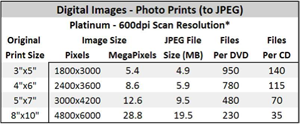Most Common Questions
FAQs Page
FAQ INDEXGeneral Questions | Photo Print Scanning | Slide & Negative Scanning | Special Format Scanning | Movie Film Digitizing | Video Digitizing
- What if my photos are of smaller or larger sizes?
- Do I need to count my photos?
- How do I estimate the number of photos I have to be scanned?
- What if my estimate of the quantity of photos is off?
- Do I need to remove my photos from albums? Do you scan albums, scrapbooks?
- 7. What if I have albums, scrapbooks and loose photos?
- What is the best way to organize, pack and ship my photo collection?
- What about scan resolution and scanning dpi options?
- Will scanning the original negatives deliver better results?
- What is "Text Note Archiving"?
- What digital file format will I receive and can I edit the images?
- What is the Index Print Option?
- What is the TV DVD Slideshow Movie Option?
- What if my slides and negatives are not 35mm or APS?
- Do I need to count my slides & negatives?
- How do I estimate the number of slides & negatives I have to be scanned?
- What if my estimate of the quantity of slides or negative frames is off?
- Do I need to remove my slides from trays and carousels?
- What is the best way to organize, pack and ship my slide or negative collection?
- What about scan resolution and scanning dpi options for slides and negatives?
- What digital file format will I receive and can I edit the images?
- Do I need to count my Special Format Negatives & Slides?
- What if my estimate of the quantity of is not accurate?
- What is the best way to organize, pack and ship my special format negatives and slides?
- What are scanning dpi options Special Format Negatives and Slides?
- 6. What digital file format will I receive and can I edit the images?
- Additional Information
Preparing and organizing your Photo Prints for shipment to FotoBridge is simple and straight forward.
Gather and organize photos into groups of 100 to 200 photos. Generally, a stack of 100 photo prints will be about one inch high. If possible, group similar size photos in the same group. While this is suggested to provide maximum protection against the possibility of corners bending during shipment – it is not required. Adding stiff cardboard together with larger prints is an alternative.
Each group of photos should be placed in a plastic utility bag and sealed. Original photographic prints may range in size from 2 in. x 2.5 in. to 8.5 in. x 12 in. and must be free of any backing or mounting materials (original photographic paper only). Pack tightly in larger box(es) while protecting from moisture with a single layer of bubble wrap or plastic inside the shipping box and additional packing material as necessary to protect during shipment. Please DO NOT use packing peanuts as they will introduce dust into our dust-free environment.








